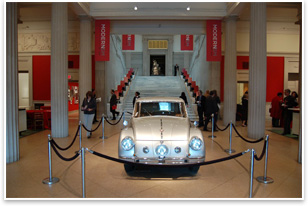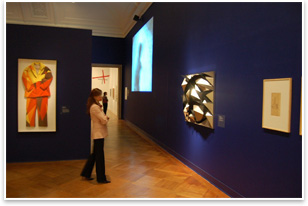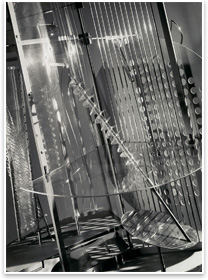
|
Largest Modernist Exhibit Ever in U.S. Opens in D.C’s Corcoran Gallery
Exhibit tracks developments across all media 1914–1939
The exhibit concludes with the 1939 New York World’s Fair, evidence that the movement had crossed the ocean to America to take root here and flourish just as Europe reentered the ordeals and ravages of yet another world war. Optimism in the end prevails: even the horrors of World War Two could not tamp out the irrepressible spirit of Modernism is part and parcel of our world today, from teapot design to skyscraper. |
||
Copyright 2007 The American Institute of Architects. All rights reserved. Home Page |
||
news headlines
practice
business
design
“Modernism: Designing a New World” will be on exhibit until July 29. The Corcoran is anticipating record crowds and recommends purchasing tickets in advance from Ticketmaster. Tickets are $14 ($10 for students; $12 for military personnel and seniors over 62.)
Captions:
1. The 1937 Tatra T87. Photo by Douglas E. Gordon, Hon. AIA.
2. Le Corbusier, Villa Savoie, Poissy, France, 1928, © Fondation Le Corbusier.
3. Throughout two floors of exhibits, the show displays an interesting mix of media, from fabric to photo to film clip. To the left is Giacomo Balla’s Futurist suit, c. 1920, Wool and cloth, from the Ottavio and Rosita Missoni Collection (© 2006 Artists Rights Society (ARS), New York / SIAE, Rome). Photo by Douglas E. Gordon, Hon. AIA.
4. László Moholy-Nagy, Lightplay: Black/White/Gray, 1930, Gelatin silver print, The Museum of Modern Art, New York, gift of the photographer (295.1937) © 2006 Artists Rights Society (ARS), New York / VG Bild-Kunst, Bonn.
5. Grete Lihotzky (Margarete Schütte-Lihotzky), Frankfurt Kitchen (from the Am Höhenblick housing estate, Ginnheim, Frankfurt), 1926–7, Various materials, V&A: W.15-2005 © V&A Images/Victoria and Albert Museum, London
The Modernism exhibit comes at a time of transformation for the Corcoran and is an apt subject as Director and President Paul Greenhalgh takes the reins of the gallery of art, he said March 13. Greenhalgh came to the Corcoran to reinvigorate it with focus on its dual mission as a gallery and a graduate school of art and design. “There is no element of the Corcoran that has not been transformed by the exhibition,” he said. With 50 students in the Corcoran program and plans for developing an annex facility in the city, the School of Art + Design is poised for growth. For more information about the Corcoran Gallery of Art—School of Art and Design, visit its Web site.





